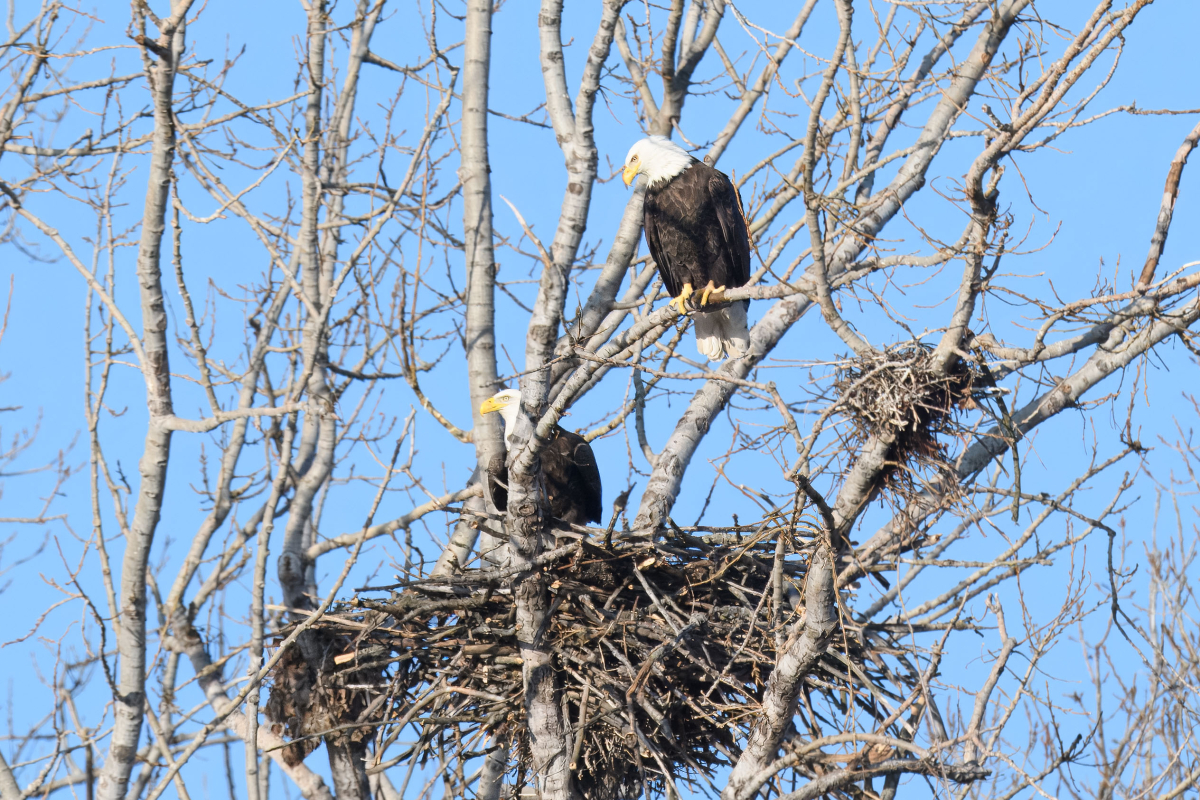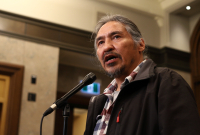Support strong Canadian climate journalism for 2025
A pair of majestic bald eagles nesting in Toronto for the first time in more than a century is a hopeful sign of improved environmental conditions, say conservationists.
“This discovery is significant as it indicates that restoration efforts to improve wildlife habitat and address pollutants in the Toronto area are yielding positive results,” said Karen McDonald, senior manager of restoration and infrastructure for the Toronto and Region Conservation Authority (TRCA).
For 50 years, bald eagles were deemed “of special concern” under Ontario’s Endangered Species Act, but they were finally removed from the list last year. In 2022, there were an estimated 2,600 nests in the province. The nesting pair is the first in Toronto’s recorded history.
Experts suggest several key factors have likely contributed to the return of eagles to Canada’s largest city. These include historical bans on Dichlorodiphenyltrichloroethane (DDT), a pesticide notable for causing eggshell thinning, which resulted in broken eggs when birds attempted to incubate them, and a transition away from leaded gasoline, which is a major environmental contaminant.
Despite the eagles' secretive nesting behaviour, their presence did not go unnoticed. In February of this year, Steven McClellan, a birder and naturalist, saw the eagles carrying sticks and starting to build the nest.
“It's truly awe-inspiring to witness — not just the eagle nest, but this entire community comprising some of the grandest birds native to Toronto, all living side by side with one another,” said McClellan. “And having been left alone, the eagle nest has been successful so far. There are two eaglets in the nest. I believe they hatched sometime between April 5 and 10.”
The eagles' nesting location cannot be disclosed to avoid disturbances, as eagles may abandon their eggs if they feel threatened.
McClellan remains vigilant, identifying potential threats such as boat traffic near the nesting site during the crucial fledgling period. As eagles often reuse the same nest for years, ongoing efforts to minimize disturbances are crucial for their long-term conservation, he added.
“During the late spring and summer months, mooring boats will host parties, set off fireworks and create other potential disturbances to the nest,” said McClellan.
Along with the City of Toronto, the TRCA will actively work to minimize disturbances around the nest, said McDonald.
“I think most people are excited that we have eagles nesting in Toronto,” said Mark Peck, member of the Toronto Ornithological Club and an ornithologist at the Royal Ontario Museum. “We should be thrilled that the local ecosystem is healthy and able to support a pair of bald eagles.”
Peck said hopefully it encourages people to care more about the local ecosystem and native species because that would be the best outcome of all.
“Bald eagles have made a remarkable recovery since the 1960s [when] pesticides and pollution which had a disastrous impact on their populations throughout much of North America,” added Peck.
According to McDonald, bald eagles have a varied diet, including fish, waterfowl, small mammals and scavenged dead animals, and exhibit opportunistic feeding behaviour. They typically lay one to three eggs annually, which have an incubation period of 34 to 36 days. Some bald eagles are residents, while others are long-distance migrants, with those in northern areas heading south for winter when water freezes.
“Toronto’s eagles may be residents as long as open water persists through winter and they can find enough food,” she said.
In theory, smaller birds and mammals would see bald eagles as a potential threat since they are an apex predator, said McDonald. However, anecdotally, staff have not observed changes in other wildlife populations in the vicinity of the nest.
“As a keystone species, bald eagles play a major role in food web interactions. As predators, they prey on other animals, helping to keep those populations fit by killing sick, weak or old individuals,” said McDonald. “As scavengers, they eat dead animals, helping to clean up our environment.
“Their decision to nest in Toronto indicates that there is a strong forage base in the city.”
The TRCA will continue monitoring the nesting eagle family while conducting other activities at the site, said McDonald. She noted the region is seeing an encouraging rebound of other important species, too.
“Toronto and Region Conservation Authority, the City of Toronto and government and community partners have been making significant investments toward improving fish and wildlife habitat on the Toronto waterfront and we are seeing the return of species like northern river otter and muskellunge.”







Comments
I could, of course, be wrong ... BUT yesterday, here in East York, I saw 6 birds soaring and gliding, riding the updrafts, and travelling from the south toward the north by northwest. Nary a wing-flap, and the wing-tip feathers "curled" upward.
I could be wrong as to whether they were bald or golden eagles, but eagles they were, definitely!
The display lasted a couple of minutes ... and made my day!
Also, there's a probably unintentional meaning in the headline, which is to infer that the eagles' return indicates bad effects brought about by former actions ... whereas the "return home" would most likely be seen as a positive thing.
One can't just assume that word-for-word translations amount to the same thing as long-established idioms.
It bespeaks one of three things: overconfidence in idiomatic usage usually found in speakers of English as a second language, over-reliance on AI (again often informed by ignorant usage), or simple laziness on the part of the headline writer.
Whichever the case, or whatever the case, one might hope that factual content not be compromised by poor grammar or other language usage issues.